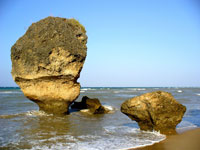East Timor country profile |
East Timor's road to independence - achieved on 20 May 2002 - was long and traumatic.
The people of the first new nation of the century suffered some of the worst atrocities of modern times.
An independent report commissioned by the UN transitional administration in East Timor said that at least 100,000 Timorese died as a result of Indonesia's 25-year occupation, which ended in 1999.
Overview
Portugal began to establish colonial control over Timor in the 16th century, when the island was divided into small states. The Netherlands later colonised the west of the island, which was formally partitioned between the two imperial powers in 1916.
Portugal invested little in Timor, and withdrew unilaterally in 1975 after deciding to dissolve its colonial empire.
Indonesia invaded within days of the Timorese declaration of independence, and used force to crush popular resistance.
 Independence followed years of oppressive rule |
Major world and regional powers did little to counter Indonesian rule, which was not recognised by the UN. Falintil guerrillas fought for independence, and their cause captured world attention in 1991 when Indonesian forces opened fire on a memorial procession in the capital, Dili, killing at least 250 people.
International pressure increased and finally persuaded Indonesia to let allow an independence referendum in 1999, during which a pro-Indonesian militia, apparently with Indonesian army support, tried in vain to use terror to discourage voters.
When the referendum showed overwhelming support for independence, the militia went on the rampage, murdering hundreds and reducing towns to ruins. An international peacekeeping force halted the mayhem and paved the way for a United Nations mission which helped reconstruct East Timor.
The rebuilding of East Timor has been one of the UN's biggest success stories. The UN Mission of Support in East Timor, Unmiset, wound up in May 2005.
But security has been precarious. An outbreak of gang violence in 2006 prompted the UN Security Council to set up a new peacekeeping force, Unmit. The UN said poverty and unemployment had exacerbated the unrest.
 Unrest in 2006 led to the deployment of peacekeepers |
As one of Asia's poorest nations, East Timor will rely on outside help for many years. The infrastructure is poor and the country is drought-prone.
However, vast offshore oil and gas fields in the Timor Sea hold much potential. East Timor and Australia have agreed to share revenues from the reserves. As a part of the deal, a decision on the disputed maritime border in the area was deferred.
East Timor is trying to foster national reconciliation. Indonesia and East Timor set up bodies to bring the perpetrators of the 1999 violence to justice. However a 2005 UN report concluded that the systems had failed to deliver. The Indonesian special court acquitted most of the 18 indicted suspects. |
President: Jose Ramos-Horta
Jose Ramos-Horta, a Nobel Peace Prize winner and former prime minister, won presidential elections in April 2007 with nearly 70% of the vote. His rival, parliament speaker and Fretilin movement candidate Francisco Guterres, conceded defeat.
 Jose Ramos-Horta, seriously wounded in a 2008 shooting |
He succeeded independence leader Xanana Gusmao in the largely ceremonial post. Mr Ramos-Horta spent two decades in exile and was a key figure in East Timor's campaign for independence, first in the Fretilin movement that he helped to found, and later as an independent politician.
He served as foreign minister and prime minister under President Gusmao.
In early 2008 he was shot by rebel soldiers in what the government described as an attempted coup. He was taken to hospital in Australia in a serious but stable condition, and resumed his duties in April.
Prime minister: Xanana Gusmao
President Ramos-Horta appointed former President Gusmao as prime minister in August 2007, breaking a political impasse following inconclusive parliamentary polls in June.
The appointment of Mr Gusmao, the leader of armed resistance to Indonesian rule, sparked violent protests from supporters of the former ruling Fretilin party.
 Xanana Gusmao |
Fretilin won 21 seats in the 65-member Parliament, well short of a majority. Mr Gusmao's party won 18 but formed a coalition comprising 37 seats.
Mr Gusamao had set up the National Congress of East Timor's Reconstruction (CNRT) in 2007 to wrest power from Fretilin.
Media
Radio is the most popular medium. State-run Radio Television Timor-Leste launched in 2002. Public radio is said to reach some 90% of the population; public TV has a smaller coverage.
Many community radio stations are on air, often with funding from international agencies and NGOs.
East Timor has a handful of daily and weekly press titles. Economic and physical factors, as well as high rates of illiteracy, limit readership.
"Journalists often feel intimidated and practice self-censorship," US-based Freedom House reported in 2010.
BBC World Service is available in Dili via BBC 105.9 FM. There are FM relays of Portuguese and Australian radio.
East Timor had around 1,800 internet users by September 2009 (InternetWorldStats.com).
The press/internet
Television
- Televisao de Timor-Leste (TVTL) - public
Radio
- Radio Nacional de Timor-Leste (RTL) - public
- Radio Falintil/Voz da Esperanca - community station which began life as a clandestine station operated by East Timor rebels
- Radio Timor Kmanek (RTK) - Catholic Church radio




